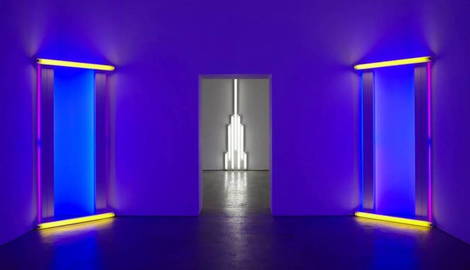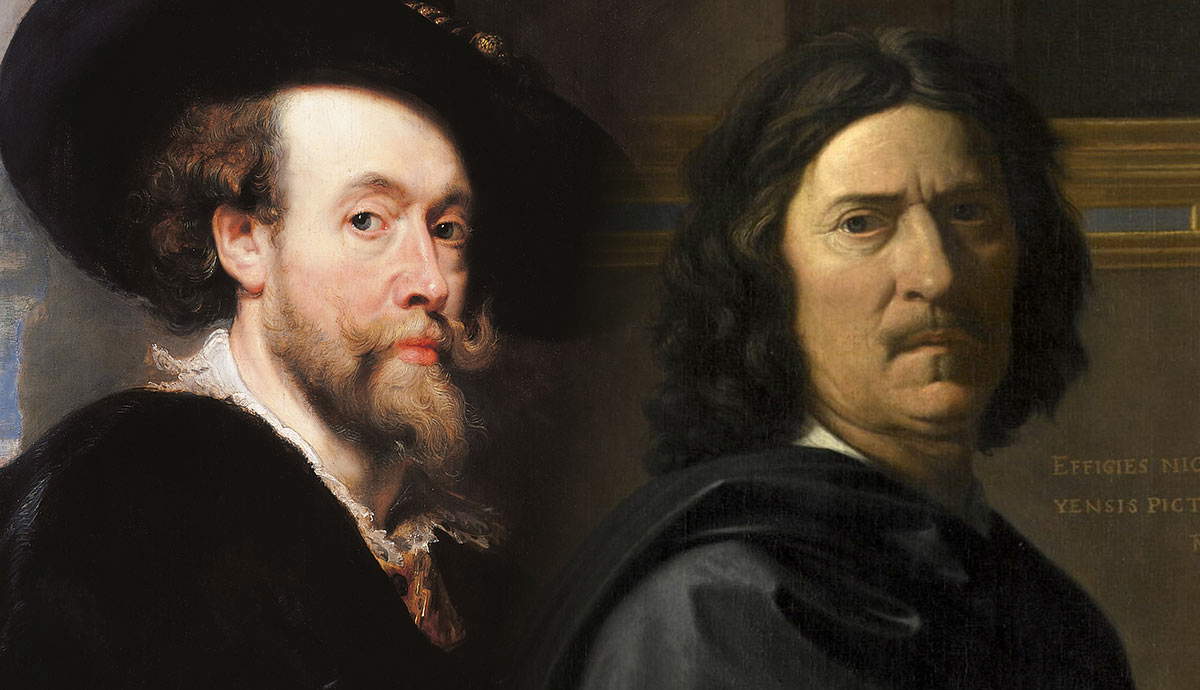
A subtle speck of fluorescence illuminates Dan Flavin’s lustrous legacy. Few artists can brag steadfast dedication to a single medium like this New York minimalist, who experimented with ambient installations for his entire electric career. His biography sheds more light on his painterly practice.
Dan Flavin’s Early Life

Dan Flavin is a native New Yorker. Born in a humble home in Jamaica, Queens, during the Great Depression, he grew up Catholic conforming to the suburban status quo. Flavin displayed an early interest in drawing. However, he betrayed his passion in 1947 by enrolling in a Brooklyn seminary at his father’s behest. Flavin remained there for six years with his twin brother David. Though never officially ordained, he maintained his fascination with Catholicism. Particularly the dramatic costumes, lighting, and customs often associated with funeral masses. In 1953, Flavin left the seminary to join the U.S. Air Force. He was sent to Korea to study meteorological technology. Then, he decided to pursue art history full time when he returned to New York City.
Dan Flavin’s First Installations

Flavin broke into New York’s art scene by landing odd jobs at the city’s greatest cultural institutions. He worked in the Guggenheim’s mailroom, and as a guard at The Museum of Modern Art, making beneficial connections to secure his future success. At MoMa, Flavin also encountered his wife Sonja Severdija in 1961, with whom he constructed his early Icons series. Reminiscent of a thickly-layered painting, the wood and Masonite constructions functioned as wall reliefs, furnished with incandescent and fluorescent bulbs. Flavin created the eight-part series while Severdija electrically wired it. Icons were in part inspired by his penchant for Russian and Greek Orthodox Churches icon paintings, using similar casts of red, yellow, and black to contrast a gold-metallic background. By doing so, Flavin aimed to maintain spiritual potency, reconceptualizing his icons to align with contemporary culture.

Though Icons was his first ambient exploration, Flavin hit his stride in 1963 when he eliminated canvas altogether. May 25th marked his fateful turning point. On that day, he grabbed a white fluorescent tube, fastened it at a 45-degree angle, and created a gentle glow now recognized worldwide as his trademark light-bar sculpture. The Diagonal Of May 25, 1963 (To Robert Rosenblum), has been praised as a milestone of Minimalist Art, a utilitarian breakthrough for the ages. One among a series of works dedicated to seminal creative figures, the ordinary fixture typified its modest Brooklyn origins during the artist’s first New York solo-shows, where Flavin’s work engulfed galleries in a wave of phosphorescence. However impermanent his installations were, audiences drew to Flavin like moths to a flame. His artistic future gleamed similarly radiant.
Minimalist Influences In Flavin’s Work

Minimalism remained a fairly emergent genre around the time Dan Flavin garnered respect. Spearheaded by artists like Frank Stella in the 1960s, the movement is often interpreted as a counterrevolution against Abstract Expressionism and Modernism. Minimalism instead favoring simplistic forms and a formal, more literal approach to artmaking. The style epitomizes modern art’s reductionist tendencies. It dates back to when Russian avant-garde leader Kazimir Malevich splattered a plain black square on a white background and proclaimed it a new-age masterpiece. In contrast to durable Minimalist mediums such as steel, aluminum, and glass, however, Flavin’s fleeting fluorescent bulbs signaled a departure from the contemporary ethos. Not only would his tubes eventually burn out, but his choice of transient light as a subject itself demonstrates his deviation from artistic norms. Evidently, Dan Flavin marched to the beat of his own painterly pulsations.

Flavin’s First Solo-Show
Flavin celebrated two successful exhibitions in 1964. In March, he displayed his Icon series at Kaymar Gallery in SoHo during a solo-show entitled Some Light. He received a positive review from his contemporary Donald Judd. Both Minimalists later showcased a one-man show at the short-lived Green Gallery. This gallery was also the first to exhibit Flavin’s innovative light-bar mechanisms in his show Fluorescent Light, a radical canon of commercially-available apparatuses. Other works included his first side-by-side floor piece titled gold, pink and red, red (1964), and Flavin’s famous nominal three (To William of Ockham) (1963). Both were a succession of luminous fluorescent lamps. By framing his architectural space with brilliant color diffusions, Flavin experimented with a location as a formal device. His art at this time placed an emphasis on manufacturing materials and reduced forms. He often mounted these installations in a room’s corner to soften its rectangular edges.

Russian Constructivism laid an inspirational foundation for Flavin to follow. Greatly influenced by Soviet-era pioneers such as Vladimir Tatlin, he admired the Constructivist concept of art as a utilitarian vehicle, focused on commonplace creativity and tangible truth. Materials dictated an artwork’s form, not vice versa, as often seen in more traditional media. Whether a means to an end or an end within itself, Constructivists used mass-supply to capture modernity’s dynamism, a changing product of their revolutionary society. Flavin revered Constructivism so much he dedicated almost forty monument pieces to Tatlin throughout his Minimalist career. They were all variations of Tatlin’s Monument To The Third International (1920). His ephemeral bulbs evoked Tatlin’s spiraling complex intended for Russian propaganda, which was conceived to stand taller than the great Eiffel Tower. Though Tatlin’s utopian complex never came to fruition, Flavin took a specific interest in his goal of uniting art and short-lived technology.
Flavin’s 1960s Success

Flavin toasted his immense critical success in the late 1960s. He had maturely mastered his lamp-lit installations, which he then simply referred to as “situations.” By 1966, his first international exhibition in Cologne proved a landmark victory for Galerie Rudolph Zwirner, a precursor to David Zwirner’s current blue-chip empire. In 1969, Flavin commemorated a comprehensive retrospective at The National Gallery of Canada in Ottawa. Each of his eight situations flooded an entire gallery space, striving to produce an all-encompassing viewer experience.

To celebrate his first-ever retrospective, Flavin even tested innovative new theories to create a complex synthesis of mood lighting and optical effects. Untitled (to S. M. with all the admiration and love which I can sense and summon) (1969) littered a lengthy 64-foot-long hallway with protruding bulbs of baby blue, pink, red, and yellow, appearing as if a glowing mirage. Stepping into its mystical aura certified a transcendental occurrence.
New Techniques Used By Flavin In The 1970s

Trickier techniques materialized in Flavin’s work by the 1970s. He coined the term “barred corridors” to describe his newfound experimentation with recontextualizing large-scale sculptures, conceived in relation to their respective habitats. In 1973, Flavin assembled his first barred corridor situation called untitled (to Jan and Ron Greenberg), constructed for a solo exhibition at the St. Louis Museum of Art. This fluorescent yellow and green barrier engaged with its spatial orientation to obstruct a viewer’s line of sight, bathing the gallery in an otherworldly intermingling of pigment. Later that year, he upgraded to a glowing green 48 x 48-inch site-specific situation called untitled (to you, Heiner, with admiration and affection), on-view today at DIA Beacon. Flavin’s dedicative titles also further reveal a layer to his fairly obscure personal life, as seen in his 1981 untitled (to my dear bitch, Airily). The dizzying tunnel-like structure paid tribute to his beloved golden retriever.
The Dan Flavin Institute

Though his career rose to new heights during the 1980s, Flavin began to suffer an onset of health complications due to his worsening diabetes. Foreseeing his own degradation, the artist took preliminary steps in maintaining his legacy, which included purchasing a remodeled firehouse in Bridgehampton, New York, to convert into an exhibition space. Perhaps not so coincidentally, his new building also had roots as a former church, providing Flavin all-the-more inspiration to retain its original idiosyncrasies. He painted its entrance hall firetruck red and moved a set of restored church doors to an exhibition room’s entrance, decorated with other religious paraphernalia such as a neon cross. Construction lasted roughly five years until 1988, during which Flavin inaugurated his new permanent dwelling with nine works he created between 1963 and 1981, including his untitled (to Robert, Joe, and Michael). The Dan Flavin Institute still functions today as a subsidiary of The DIA Art Foundation.
How Flavin Created His Last Installations

Dan Flavin undertook his final projects in the 1990s as his diabetes exacerbated. In 1992, he agreed to create an extensive light situation for a new exhibition at the Guggenheim Museum: a two-level ramp flushed in flickering green, blue, purple, and orange. With this spiral, Flavin also commemorated his marriage to his second wife Tracy Harris, which took place on-site in the museum’s rotunda. untitled (to Tracy, to celebrate the love of a lifetime) honored the artist’s last highly-publicized public appearance, if not a bittersweet jubilee.

Having undergone strenuous surgery to amputate parts of his feet, by 1996 Flavin could only muster the physical strength to direct his last large-scale installation for the Prada Foundation in Milan, Italy. Flavin’s untitled neatly fused his life’s vocation into a tiny chromatic chapel, permeated by his signature hues of green, pink, and blue ultraviolet lights. His last situation at Santa Maria Annunziata Church opened a year after his untimely death in 1996.
Dan Flavin’s Posthumous Recognition
Beyond the acclaim Dan Flavin sustained during his lifetime, social media has now elevated him to a higher benchmark of stardom. Subsequent to his death in the late 1990s, Flavin underwent a resurgence in popularity due to his 2004 touring exhibition Dan Flavin: A Retrospective. From The National Gallery of Art in Washington D.C to LACMA in Los Angeles, and eventually Munich, Paris, and London, the exhibition featured nearly fifty light installations and some never-before-seen sketches. By its conclusion in 2007, popular online platforms like Twitter planted seeds for Instagram, which now serves one of Flavin’s largest makeshift archives. Maybe his comeback speaks to a vintage Minimalist revival in the millennial age, his installations now dedicated to figures both living and dead. Or perhaps it indicates a larger paradoxical permanence present throughout his temporary body of work.
Dan Flavin’s ageless situations call upon art-historical traditions, contemporary politics, and ancient religions alike to reveal perseverance beyond physical limitations. Time may alter how we probe his fluorescent installations, but his tangible mark remains fairly unscathed, imprinted in our collective memories at first sight of an ordinary light fixture. Decades after his death, viewers have understood his work beyond the Minimalist movement it had been previously ascribed to, as if existing in an ethereal realm all his own. Today, Dan Flavin’s cultural legacy still beams brightly for all humanity to soak in.









